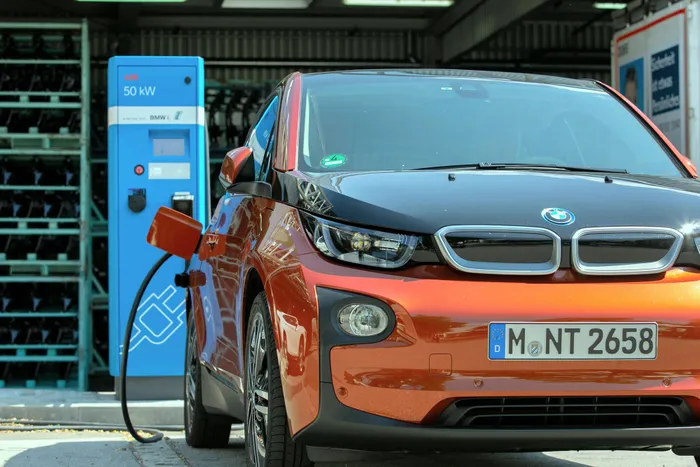Localisation remains critical in SA EV transition - Naacam

An i3 battery-powered automobile, manufactured by BMW, sits beside an electrical charging station. Photo: Bloomberg
The commitment by the Department of Trade, Industry and Competition (Dtic) on the Electric Vehicle (EV) White Paper was a welcome move, however, localisation remained a critical factor in South Africa’s automotive industrialisation strategy, the National Association of Automotive Component and Allied Manufacturers (Naacam) CEO Renai Moothilal said yesterday.
Moothilal said in an interview with Business Report that without transitioning, the sector might lose its major direct component and vehicle export market.
He said the component sector alone accounted for more than 80 000 direct jobs and contributed significantly to the sector's overall contribution to gross domestic product (GDP) of 4.9%.
“Without a domestic component sector, the SA automotive industry could effectively become a hollowed out assembly base at most and result in significant job losses and reduced contribution to GDP," Moothilal said.
As outlined in the White Paper, production is to be placed at the centre of an new energy vehicle (NEV) transition.
Naacam said support for component manufacturers investing in NEV technologies and efforts to improve the overall competitiveness of the sector such as attending to the domestic energy and logistics challenges were critical to ensure the sector was able to competitively transition.
“Naacam is pleased to see all of these elements addressed in the EV white paper. The release of the White Paper will hopefully give confidence to investors and allow OEMs (original equipment manufacturers) to commit to producing EVs in South Africa and disclosing what those volumes will be an element which is critical for the component sector’s transition."
Moothilal said the component sector was fairly ready for the EV transition given the nature of how sourcing from OEMs to component suppliers worked. Component companies responded to technology changes every time there was a model change, and this shift would be no different.
“There are already component manufacturers who are exporting components into EV production lines. The majority who still produce components specifically for internal combustion (ICE) vehicles is because the domestic vehicle production plants have not transitioned yet. Once local OEMs begin to issue request for quotes for NEV production and create demand certainty, suppliers will respond accordingly, making the necessary investments as they do every seven to 10 years when a vehicle model reaches the end of its life cycle,” he said.
Naacam said given that South Africa did not have a strong, globally integrated R&D base, the transition would require investment in onshoring NEV component intellectual property and technologies. Improving infrastructure, including energy provision, ports and rail, were also vital for the sector's overall competitiveness and need to be prioritised.
That being said, Moothilal added that SA continued, at least in the short to medium term, to receive demand for ICE vehicles and components, and it was important that in the NEV transition, the competitiveness of the ICE industry was not eroded while demand still existed.
“Hence maintaining the technology agnostic framework is key, as mentioned by (Dtic) Minister Ebrahim Patel when outlining a willingness to have the plan accommodate battery, as well as fuel cell electric vehicles, and smart synthetic fuel driven internal combustion vehicles. The components base in SA is ready and excited to support whatever those technologies are that may be assembled in SA, and also scale up on global export potential,” said Moothilal.
EaRlier this week, Zero Carbon Charge co-director and founder Joubert Roux said the White Paper’s focus on capacitating and greening the Eskom grid might unnecessarily delay the transition to EVs. Instead, the focus should be on immediately developing off-grid EV charging stations based on renewable sources,
BUSINESS REPORT
Related Topics: